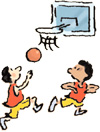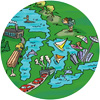Background – Species and their Spaces |
Nature has a way of maintaining a balance among living things. If the balance in the natural world and the relationship among all living species, which is called biodiversity, is upset, there is a problem. Biodiversity encompasses the differences in genes, species and ecosystems and we depend on biodiversity to survive.
Just like people, wildlife need an environment that is suitable for them. Habitat is the place where wild plants and animals can find provides food, water, shelter and a place to raise their offspring. Each species has unique habitat needs and so a broad range of habitat is necessary to provide for different species’ needs. Healthy wild spaces that can be used as habitat include wetlands, forests, meadows and lakes. But more and more, these spaces are being disturbed and destroyed, primarily by human activities in urban, suburban and rural areas. Natural habitats under the most pressure are forests, grasslands, wetlands and the Great Lakesand their watersheds. The highly populated, Carolinian ecozone in southwestern Ontario is perhaps the most wildlife-rich area in the country; and also home to about one-third of theCanada’s species at risk.
Wildlife and plants are suffering because without the habitat they need, they cannot survive. In addition to human activities, wild species face other stresses too that put them “at risk”, such as climate change and introduction of invasive species. In Canada more than 400 wildlife species are considered to be “at risk”, meaning that, without specific efforts to protect and recover them, they are may soon be lost forever.
Wetlands are among the most productive habitats on earth. Not land or water but a fluid combination of both, wetlands are all built on a simple foundation: water becomes trapped, either though poor drainage, periodic flooding or by coastal barriers, such as sandbars, and a wetland – that unique mix of land and water, is born. Today, wetlands are increasingly recognized as dynamic, productive and diverse ecosystems. They are wildlife nurseries and nesting sites, feeding grounds and resting places, water filters and reservoirs, and much more. As valuable as they are, wetlands are still being destroyed at an alarming rate. If we continue to lose wetlands, a large and important piece of the natural system that keeps our world healthy will disappear.
It’s important to learn all you can about wildlife and their habitats and what each of us can do to work toward saving spaces for species. By working together, people can find ways to live without negatively affecting biodiversity. At school, you can investigate the importance of the variety of living things on earth and right in your own community.
Where are spaces and species important at school? |
 |
School Grounds: preserve and/or create a green space with planting of native species.
Classrooms: take the classroom outside to find a stimulating, biologically-diverse learning environment.
EntireSchool: promote reduce, reuse, recycle – use less, use more than once, and put it in the recycle box rather than the garbage; conserve water and energy.
 |
Taking Action at School |
It’s hard to imagine Canada without wildlife so it’s important to learn about habitat loss and what can be done at school to help solve the problem.
Some ideas for taking action:
·Kick off spring in your school by celebrating National Wildlife Week inOntario, the second week of April (www.wildlifeweek.org).
·Make Earth Day on April 22 a school wide celebration.
·Find out about and encourage biodiversity conservation in the community.
·Conduct inventories of local flora and fauna.
·Green some of the spaces in the school grounds and parking lot with a project to plant native species.
·Take advantage of Nature Canada’s Frog Watch and Species at Risk classroom education programs to add excitement to the classroom.
Helpful Spaces and Species Web Sites
The following Web sites have interesting information and exciting opportunities to learn about and be active in saving spaces for species.
www.ec.gc.ca/youth/nature_e.html
Surf the Web sites listed in this Nature & Wildlife gateway to learn about animal and plant biodiversity in Canada and about species at risk. Find out how to protect ecosystems and avoid the loss of species and genetic diversity that result from human activities.
Kids’ Zone provides a window into biodiversity with segments especially for kids and for educators.
www.cws-scf.ec.gc.ca/index_e.cfm
Canadian Wildlife Service Web site is a wealth of information about biodiversity, habitat, and wildlife.
www.on.ec.gc.ca/wildlife/sarwheel/main-e.cfm
Find out all kinds of things about species at risk in Canada and use the quick links to information about wetlands, and Project WILDSPACE™.
Nature Canada’s Species at Risk Education Guide provides an educational package designed around the life science and environmental science components of the grades 3-7 curriculum for each province. It provides the structure for teaching plus a variety of exciting activities.
|
Ideas for Great Acts
|
Design, restore and maintain diverse habitats as a community project
Naturalize your school grounds www.ontarionature.org/educate/schoolground.html
 |
Games and Activities |
www.on.ec.gc.ca/greatlakeskids
Follow Dr. Chip Weseloh, wildlife biologist, as he goes out into the field to study birds in the video entitled, “Protecting our Wildlife”.
Earth Day Canada’s environmental education Web site offers great resources and curriculum connections, plus games, quizzes and activities for parents and kids.
 |
Students Leading the Way – Tell us what actions you’re taking to save Spaces for Species! |
 |



